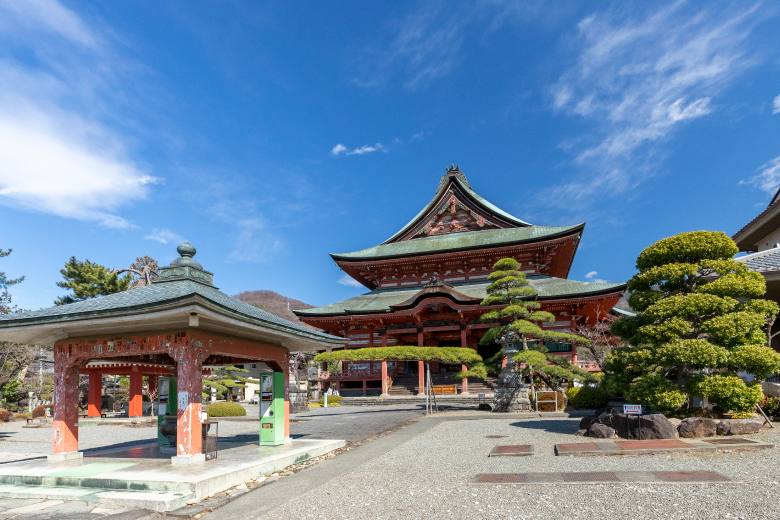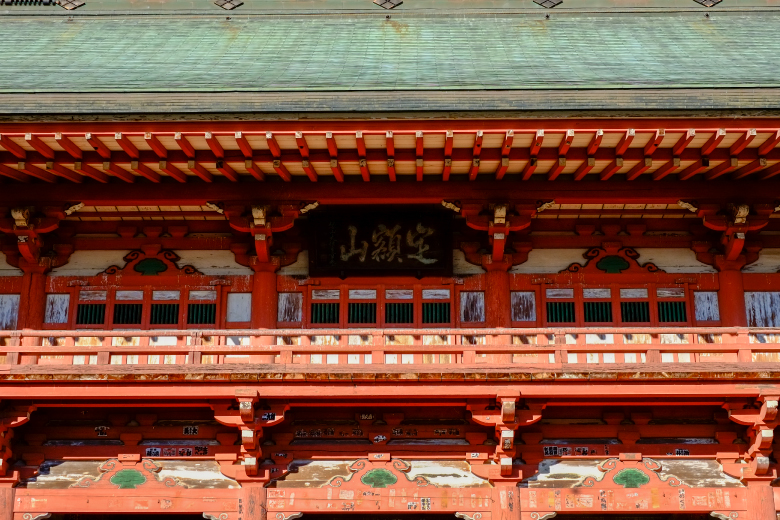Kai Zenko-ji Temple is a Jodo sect temple founded by Takeda Shingen in 1558 when he brought the main deity image of Zenko-ji Nyorai from Shinano Zenko-ji Temple in Nagano to Kai along with the temple’s treasures and priests, fearing that Shinano Zenko-ji might be destroyed in the Battle of Kawanakajima that was ongoing at the time. During the Edo Period (1603-1868), it served as a hall where mortuary tablets of the Tokugawa Clan were kept.
The T-shaped main hall called Kondo (Golden Hall) is the largest wooden building in eastern Japan, measuring approximately 49 meters in the longitudinal direction and 27 meters in height. The hall and main gate of the temple were rebuilt in 1796 after they were lost in a fire. Both are designated National Important Cultural Properties.
Inside the Golden Hall, two huge dragons dominate the ceiling, painted by an Edo artist called Kisai. This portion of the ceiling is a suspended ceiling, such that when visitors stand beneath the ceiling and clap their hands, they can hear the dragons “weep.” Weeping dragons are found in many temples, but this is said to be the largest in Japan.
A “Kaidan Meguri” tour is offered in the Golden Hall, as at Shinano Zenko-ji in Nagano. It is a tour where visitors walk through a completely dark passage created in the shape of the kanji character “心” (heart) in search of a key that is believed to grant a spiritual connection with the main deity of the shrine to anyone who finds and touches it.
The bell tower houses a bronze bell that is known as having been transported from Shinshu by dragging it. It is a Prefectural Cultural Property that continues to toll the time to this day. The cemetery embraces the grave of Kato Mitsuyasu, a feudal lord under Toyotomi Hideyoshi during the Warring States Period (1467–1615). The treasure hall displays a collection of cultural properties, including a statue of Minamoto Sanetomo created during the Kamakura Period (1185–1333), a statue of Sho Kannon (Holy Goddess of Mercy) offered by Tokugawa Iemitsu, and a red-sealed official document by Takeda Shingen.
The T-shaped main hall called Kondo (Golden Hall) is the largest wooden building in eastern Japan, measuring approximately 49 meters in the longitudinal direction and 27 meters in height. The hall and main gate of the temple were rebuilt in 1796 after they were lost in a fire. Both are designated National Important Cultural Properties.
Inside the Golden Hall, two huge dragons dominate the ceiling, painted by an Edo artist called Kisai. This portion of the ceiling is a suspended ceiling, such that when visitors stand beneath the ceiling and clap their hands, they can hear the dragons “weep.” Weeping dragons are found in many temples, but this is said to be the largest in Japan.
A “Kaidan Meguri” tour is offered in the Golden Hall, as at Shinano Zenko-ji in Nagano. It is a tour where visitors walk through a completely dark passage created in the shape of the kanji character “心” (heart) in search of a key that is believed to grant a spiritual connection with the main deity of the shrine to anyone who finds and touches it.
The bell tower houses a bronze bell that is known as having been transported from Shinshu by dragging it. It is a Prefectural Cultural Property that continues to toll the time to this day. The cemetery embraces the grave of Kato Mitsuyasu, a feudal lord under Toyotomi Hideyoshi during the Warring States Period (1467–1615). The treasure hall displays a collection of cultural properties, including a statue of Minamoto Sanetomo created during the Kamakura Period (1185–1333), a statue of Sho Kannon (Holy Goddess of Mercy) offered by Tokugawa Iemitsu, and a red-sealed official document by Takeda Shingen.
COURSE MAP
Let's go to the next spot!
- 1.1km / 3min by car
- 10Sakaorinomiya Shrine

